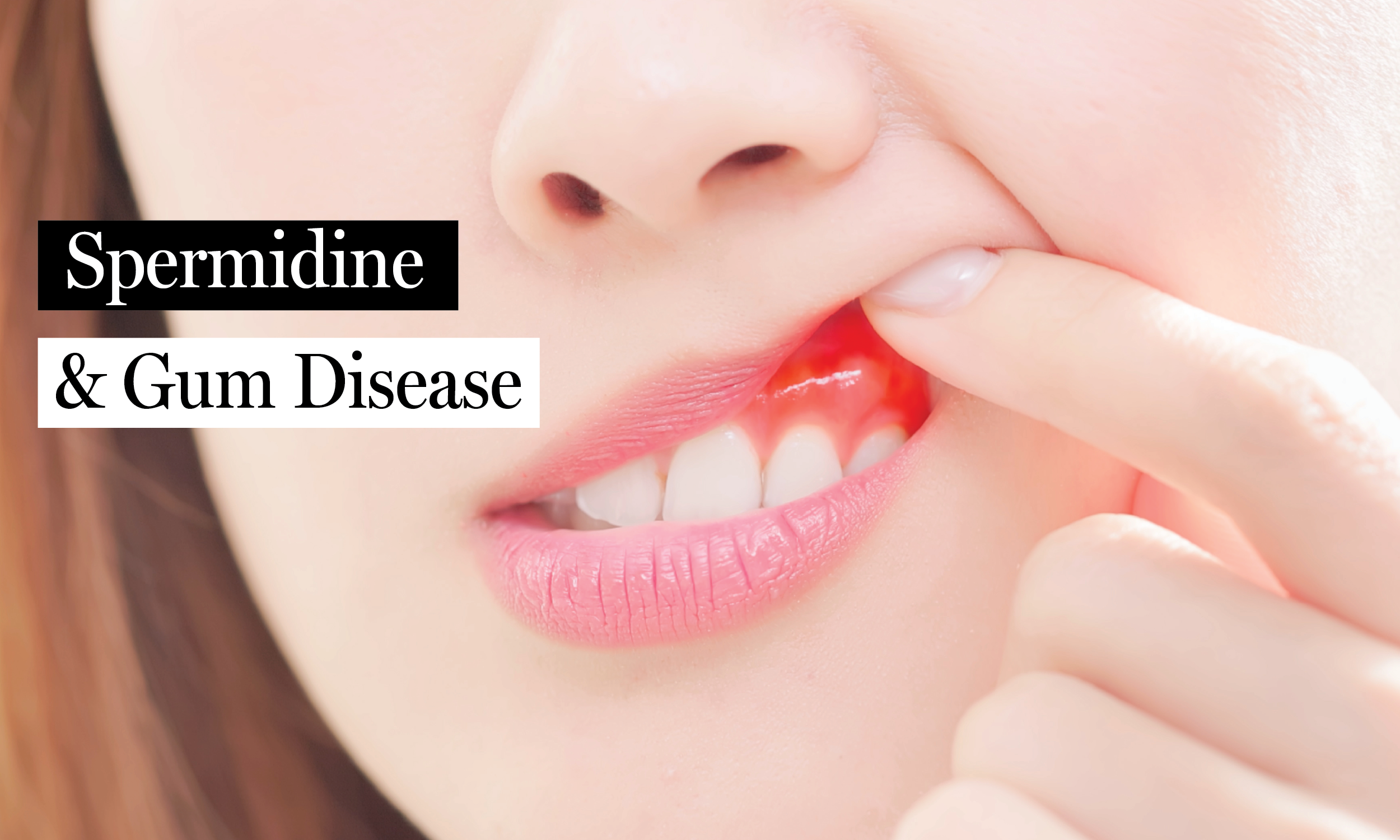
Periodontitis is a chronic inflammatory condition that not only damages your gums but gradually erodes the very structures anchoring your teeth. It is a common complication in individuals with Type 2 Diabetes. The interplay between diabetes and periodontitis creates a vicious cycle of inflammation, oxidative stress, and impaired tissue repair. A recent study published in Free Radical Biology and Medicine sheds light on a promising therapeutic approach using spermidine to combat diabetic periodontitis. Time to bite into the science!
How diabetes makes periodontitis worse
First things first, let’s chew on some definitions (we will stop the tooth puns here):
Periodontitis is the advanced stage of gum disease, where the infection damages the bone and tissues that hold your teeth in place. It can lead to tooth loss if untreated. Gum disease typically begins as gingivitis, which is a milder form marked by red, swollen, and bleeding gums, before progressing to periodontitis when inflammation and bacterial infection spread deeper below the gum line. [As a side note, if your gums regularly bleed when you brush or floss, it’s a good idea to check in with your dentist!]
Type 2 Diabetes (T2D) is a chronic condition where the body doesn’t use insulin properly, leading to high blood sugar levels over time. T2D can lead to serious complications, including heart disease, kidney problems, eye damage, nerve damage, foot issues, and gum disease. Specifically, T2D speeds up the breakdown of gum tissue, leading to more bone loss, chronic inflammation, and slower healing.
At the cellular level, the high-sugar, high-inflammation environment of diabetes affects key repair cells in the gums, called periodontal ligament stem cells (PDLSCs). These cells become senescent, meaning they stop dividing and start releasing harmful signals that trigger even more inflammation. This process is fueled by oxidative stress, mitochondrial dysfunction, and activation of the cGAS-STING pathway, a cellular alarm system part of the immune system that plays a role in recognizing DNA from invading pathogens and damaged cells, triggering an immune response. When it is dysregulated, it can lead to autoimmune diseases and chronic inflammation.

Spermidine alleviates diabetic gum disease – Recap of the study.
In conditions that mimic diabetes, human Periodontal Ligament Stem Cells (PDLSCs) undergo cellular senescence, which impairs tissue regeneration. Senescent PDLSCs exhibit mitochondrial dysfunction, where oxidized mitochondrial DNA activates the cGAS-STING-TBK1 signaling pathway, amplifying both inflammatory and senescence signals. Spermidine reactivates osteogenic differentiation in human PDLSCs, improves mitochondrial function, and reverses cellular senescence through mitophagy. Specifically, spermidine-induced mitophagy removes dysfunctional mitochondria with impaired membrane potential and their oxidized DNA, reducing STING activation and interrupting the positive feedback loop of senescence. In animal models, oxidative stress depletes Gli1+ stem cells in diabetic periodontitis mice, but spermidine promotes tissue regeneration by recruiting Gli1+ PDLSCs. Figure modified from Zhou et al. © 2025 Melissa Cano. All rights reserved.
What this new study shows: spermidine could be a solution to diabetic periodontitis
The study explored how diabetes worsens periodontitis and whether spermidine could reverse the damage by targeting gum tissue repair cells or PDLSCs. To induce Type 2 Diabetes (T2D) in mice, researchers used a high-fat diet and streptozotocin injections, which damage the insulin-producing cells in the pancreas, and triggered periodontitis by ligating the maxillary second molar. Spermidine was then injected locally into the periodontal defect area of these diabetic mice. In parallel, human PDLSCs were exposed to a high-glucose, inflammatory environment to mimic diabetic conditions in the lab. The researchers analyzed tissue damage, bone loss, and PDLSC senescence using a range of imaging and molecular techniques. Their findings revealed that spermidine can reverse the damage caused by diabetic periodontitis. How? Here are the key mechanisms:
- Reversal of cellular senescence: Spermidine inhibited the senescence of human PDLSCs in a high-glucose inflammatory environment. It reduced oxidative stress, improved mitochondrial function, and restored the cells' ability to proliferate and differentiate into bone-forming cells.
- Activation of mitophagy: Spermidine activated mitophagy, a process that removes damaged mitochondria, thereby reducing mitochondrial DNA leakage and oxidative damage. This, in turn, inhibited the activation of the cGAS-STING pathway, breaking the cycle of inflammation and senescence.
- Regeneration of tissue: In a diabetic periodontitis mouse model, local injections of spermidine significantly reduced bone loss, restored periodontal ligament structure, and recruited Gli1+ stem cells (a marker for PDLSCs) to the damaged area. This highlights spermidine's ability to promote tissue repair in vivo.
- Increase in oxidative phosphorylation: Spermidine increased oxygen consumption rates and ATP production, restoring energy metabolism in PDLSCs, effectively rejuvenating the cells and improving their regenerative potential.
- Inhibition of inflammatory pathways: Spermidine reduced mitochondrial DNA leakage caused by mitochondrial dysfunction, which releases oxidized DNA into the cytoplasm and contributes to PDLSC senescence. This helped suppress the activation of the cGAS-STING-TBK1 signaling pathway, a major driver of inflammation and cellular aging in PDLSCs.
Spermidine: a promising treatment for gum disease
This study positions spermidine as a novel therapeutic agent for diabetic periodontitis. Its ability to reverse cellular senescence, enhance mitochondrial function, and promote tissue regeneration offers a targeted approach to address the root causes of gum disease in diabetes. What’s even more exciting is that the local administration of spermidine in the animal models used in this study suggests that it could be a simple, minimally invasive treatment option for real-world use. While the focus is on diabetic periodontitis, the findings could extend to other forms of gum disease. Indeed, spermidine's ability to enhance mitochondrial function and reduce oxidative stress may have applications in treating gum disease in non-diabetic patients as well.
Looking beyond just gum disease, these results suggest spermidine could play a significant role in treating other chronic conditions associated with inflammation, oxidative stress, and mitochondrial dysfunction. Since it’s a natural compound with a solid safety record, spermidine is an exciting candidate for further research and clinical development.
As we move forward, there are still important questions to explore, such as how spermidine recruits Gli1+ stem cells to damaged tissues and whether its effects can be replicated in human clinical trials. Answering these questions will be key to unlocking the full potential of spermidine in treating gum disease and other inflammatory conditions. But for now, it’s time to flash a big smile—the future is looking bright!
TLDR!
Spermidine offers a promising breakthrough in the treatment of diabetic periodontitis, providing hope for millions of individuals affected by this challenging condition. By reversing the senescence of the gum tissue repair cells and promoting the repair of periodontal tissue, spermidine targets the underlying cellular and molecular mechanisms that drive tissue destruction. This not only helps alleviate symptoms but also restores the regenerative potential of the gums.







